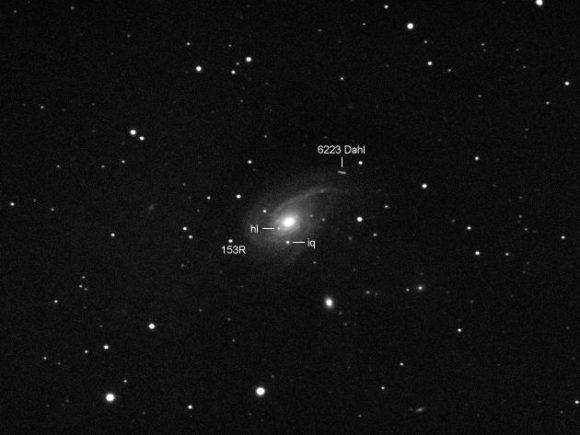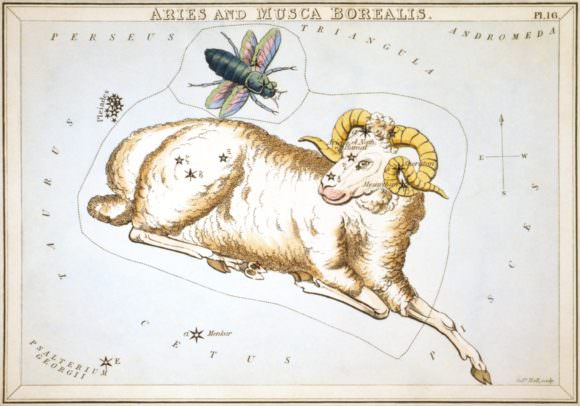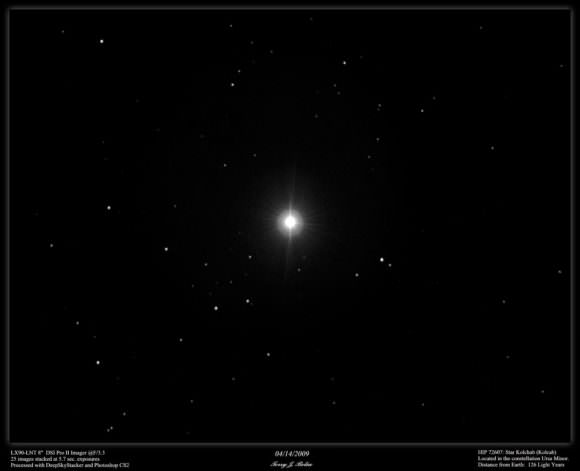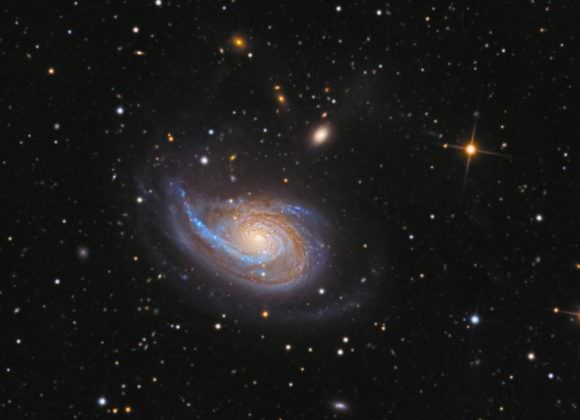Welcome back to constellation Friday! Today, in honor of our dear friend and contributor, Tammy Plotner, we examine the Aries constellation. Enjoy!
In the 2nd century CE, Greek-Egyptian astronomer Claudius Ptolemaeus (aka. Ptolemy) compiled a list of the then-known 48 constellations. His treatise, known as the Almagest, would serve as the authoritative source of astronomy for over a thousand years to come. Since the development of modern telescopes and astronomy, this list has come to be expanded to include the 88 constellation that are recognized by the International Astronomical Union (IAU) today.
Of these constellations, Aries – named in honor of the Ram from classical Greek mythology – is featured rather prominently. This faint constellation has deep roots, and is believed to date all the way back to the astrological systems of the ancient Babylonians. Positioned on the ecliptic plane, it is bordered by constellations of Perseus, Triangulum, Pisces, Cetus and Taurus, and is also the traditional home of the vernal equinox.
Name and Meaning:
In classical mythology, Aries is the Ram – perhaps the golden one who saved Helle and Phrixos from a king Cretheus for false accusations. Aries the Ram is the also the first astrological sign in the Zodiac – associated with the god Ares and masculinity. Under the tropical zodiac, the Sun is in Aries roughly from March 21st to April 19th, by definition beginning at vernal equinox. The vernal equinox has moved in the constellation Pisces, but sometimes it is still called the first point of Aries.

Notable Features:
Aries has three prominent stars forming an asterism – Alpha, Beta and Gamma Arietis, all of which have been traditionally used for navigation. Alpha Arietis, called Hamal, is an orange giant with an apparent magnitude of 2.0, making it the brightest star in the constellation. Located 66 light-years from Earth, this star’s traditional name comes from the Arabic word for “lamb”, or “head of the ram” (ras al-hamal).
Beta Arietis (Sheratan) is a blue-white star star with an apparent magnitude of 2.64 that is located 59 light-years from Earth. Its traditional name comes from the Arabic word “sharatayn“, which means “the two signs”, referring to both Beta and Gamma Areitis in their position as heralds of the vernal equinox. This star is also a spectroscopic binary, meaning that its companion is only known through analysis of the spectra.
Gamma Arietis (Mesarthim) is binary star with two white-hued components that are located 164 light-years from Earth. Its traditional name is the subject of scholarly debate, with some claiming it may be derived from a corruption of “al-sharatan” (Arabic for “pair”), a word for “fat ram”, from the Sanskrit “first star of Aries”, or the Hebrew for “ministerial servants”.
Aries is also home to several faint Deep Sky Objects. These include NGC 772, an unbarred spiral galaxy located 130 million light-years from Earth which is visible to the southeast of Beta Arietis. It has a small companion galaxy, NGC 770, that is about 113,000 light-years away from the larger galaxy. Another spiral galaxy in Aries is NGC 673, a weakly barred spiral galaxy that is 235 million light-years distant from Earth.

For those who have a larger telescope, there are several faint galaxies that can be spotted. NGC 697 is a good example, a 13th magnitude spiral galaxy located within Aries that is part of a galaxy group. NGC 972 is also part of a galaxy group and is equally faint, at magnitude 12. NGC 1156 is a dwarf irregular galaxy that is considered to a Magellanic-type, with a larger than average core and a a H II nucleus containing zones of counter-rotating gas (which is thought to be the result of tidal interactions with another gas-rich galaxy some time in the past).
Aries is also home to several meteor showers. The May Arietids are a daylight meteor shower which begins between May 4th and June 6th with maximum activity happening on May 16th. The Epsilon Arietids are also a daylight occurrence, which are active between April 25th to May 27th with peak activity on May 9th. The very best daytime Arietids occur from May 22nd to July 2nd with a maximum on June 8th, when the meteoroid stream produces one meteor every minute.
Historically speaking, the Delta Arietid meteor shower was first noted in 1959 by analyzing photographic meteor orbits, and activity occurs between December 8th and December 13th. The Autumn Arietid meteor shower begins on or about September 7th and runs through October 27th. Maximum activity occurs about October 8th, and the fall rate is about 3 to 5 (average) meteors per hour.
History of Observation:
Though representations of Aries as The Ram comes to us from classical antiquity, it is believed that this constellation has existed since the days of ancient Babylon. In the description of the Babylonian zodiac contained in the MUL.APIN (the compendium on Babylonian astrology) Aries was the final station along the ecliptic, and was known as MULLÚ.?UN.GÁ, which translates to “The Agrarian Worker” or “The Hired Man.”

The shift in identification from the constellation as the Agrarian Worker to the Ram likely occurred in later Babylonian tradition because of its growing association with Dumuzi the Shepherd. By the time the MUL.APIN was created (1000 BCE) , modern Aries was identified with both Dumuzi’s ram and a hired laborer.
In ancient Egyptian astronomy, Aries was associated with the god Amon-Ra, who was depicted as a man with a ram’s head and represented fertility and creativity. Because it was the location of the vernal equinox, it was called the “Indicator of the Reborn Sun”. Aries acquired the title of “Lord of the Head” in Egypt, referring to its symbolic and mythological importance.
In traditional Chinese astronomy, stars from Aries were used in several constellations. Alpha, Beta, and Gamma Arietis formed a constellation called Lou, variously translated as “bond”, “lasso”, and “sickle”, which was associated with the ritual sacrifice of cattle. This constellation has also been associated with harvest-time as it could represent a woman carrying a basket of food on her head. Other stars were part of the constellations Wei – the namesake of the 17th lunar mansion, representing granaries – and Tianyin, thought to represent the Emperor’s hunting partner.
Similarly, in Hindu astronomy, Beta and Gamma Arietis were known as the Aswins, and were associated with the first lunar mansion. Because the Hindu new year began with the vernal equinox, the Rig Veda contains over 50 new-year’s related hymns to the twins, making them some of the most prominent characters in the work. Aries itself was known as “Aja” and “Mesha“.

In Hebrew astronomy Aries was named “Teli“, which signified either Simeon or Gad, and generally symbolizes the “Lamb of the World”. The neighboring Syrians and Turks named the constellation “Amru” and “Kuzi”, respectively. In indigenous Peruvian astronomy, a constellation with most of the same stars was called the “Market Moon” and the “Kneeling Terrace”, as a reminder of when to hold the annual harvest festival, Ayri Huay.
In his Almagest, Ptolemy listed Aries as one of the 48 constellations. This tradition was maintained by Medieval Muslim astronomers such as al-Sufi, who modeled the constellation as a ram based on the precedent of Ptolemy. During the Scientific Revolution, John Flamsteed also followed Ptolemy’s description in his Atlas Coelestis – a star atlas that was published posthumously in 1729. In 1922, the International Astronomical Union adopted it as one of the 88 constellation and defined its recommended three-letter abbreviation as “Ari”.
Finding Aries:
Only its Alpha and Beta stars – Hamal and Sheratan – are easy to recognize. They represent the head of the Ram. Teegarden’s star, a recent discovery in the constellation of Aries, is one of Sun’s closest neighbors (around 12 light years away). It appears to be a red dwarf, a class of low temperature and low luminosity stars. This would explain why it was not discovered earlier, since it has an apparent magnitude of only 15.4.
For the unaided eye and observing with binoculars, check out Alpha Arietis – aka. Hamal. It has one of the most accurately-measured angular diameters – 0.00680″ (the width of a penny seen from 60 km away) – and is some 55 times brighter and five times more massive than our Sun.

Now have a look at Beta Arietis – aka. Sheratan. Beta shines at magnitude 2.7 and is located 60 light years from Earth. Back at the turn of the 20th century it was discovered to be a spectroscopic binary, with a period of 106 days. According to Jim Kaler’s fine research,”Sheratan stands out as a result of the extremely high eccentricity of the orbit (0.88), the companion trapped in a record-holding elongated path.”
Moreover, the star is an observational treasure. The two stars are so close together that they cannot be separated directly through the telescope, and all we ever actually see is one star. Detection via the spectrum also requires that the stars to be close and moving quickly. However, sophisticated observation of Sheratan with an interferometer, a device that makes use of the interfering properties of light to resolve ultra-fine detail, allow (as for the brighter component of Mizar) the pair to be resolved.
The masses of the stars (through gravitational theory) can then be measured with high accuracy. Averaging 0.64 Astronomical Units apart (89 percent Venus’ distance from the Sun), a star with the mass of the Sun (1.02 solar) orbits a double-solar-mass (2.00) star every 107 days. Since luminosity is very sensitive to mass, 95 percent of the light of the system is produced by the heavier star.
The huge eccentricity adds the spice. As they wheel around each other, the smaller one (undoubtedly a class G star like the Sun) approaches as close as 0.08 AU (only 20 percent Mercury’s distance from the Sun), and then half an orbit later loops around at 1.2 AU, 16 times farther away and 20 percent farther than Earth from the Sun.

No close planets could survive the gravitational onslaught. Such stars, in which the doubling is “visible” by two techniques (only about 40 are known, and Sheratan is one of the brighter ones), allows accurate assessment of the theoretical relation between stellar mass and luminosity, and provides powerful evidence that the theory is correct. The higher mass star will die first. In a couple billion years, the lower mass G star will be the king of the pair, while the current luminary will be a shrunken dim white dwarf.
For those using small telescopes, a good place to stargaze is around Gamma Arietis – aka. Mesarthim. This wide, double star with blue/white members of 4.6 magnitude is an easy one to spot. For this reason, Mesarthim was one of the very first double stars to be discovered by Robert Hooke while looking for a comet in 1664. Another easily spotted star is the binary star is Lambda, it is also a very wide double with a 5th magnitude primary and 5th magnitude secondary. For something a little harder, try 5th magnitude Pi.
The 8.8 magnitude companion is on 3 arc seconds away and will really test the resolving power of your optics and the stability of your skies. Use your highest power. If you don’t have luck, try 30 Arietis. The magnitude 7 primary star is a lovely golden yellow and the secondary is about magnitude 8 and is a distinct blue separated by about 40 arc seconds.
For a nice outreach project, try observing 53 Arietis – the “Runaway star”. Along with AE Aurigae and Mu Columbae 53 Arietis appears to be cruising right along from the region of the Great Orion Nebula!
Thank you for reading; and as always, enjoy your stargazing!
We have written many interesting articles about the constellation here at Universe Today. Here is What Are The Constellations?, What Is The Zodiac?, and Zodiac Signs And Their Dates.
Be sure to check out The Messier Catalog while you’re at it!
For more information, check out the IAUs list of Constellations, and the Students for the Exploration and Development of Space page on Aries and Constellation Families.


I miss Tammy…